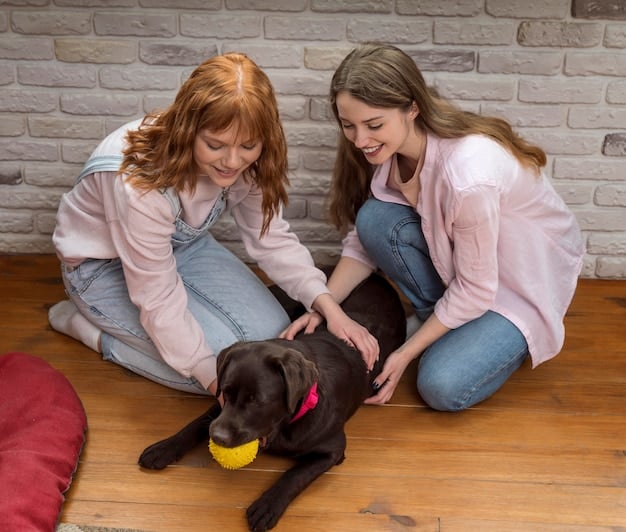Early Socialization: Shaping Puppy Behavior During the 12-Week Critical Period

The impact of early socialization on puppy behavior, particularly within the critical 12-week period, is profound, influencing their future temperament, confidence, and ability to interact positively with humans and other animals.
Unlocking your puppy’s full potential hinges on the impact of early socialization. The 12-week critical period is a cornerstone of their development, setting the stage for a well-adjusted and happy companion. Understanding the impact of early socialization on puppy behavior: a 12-week critical period is essential for any responsible dog owner.
Understanding the Critical Period for Puppy Socialization
The critical period for puppy socialization, primarily spanning the first 12 weeks of their life, is a formative time. During this phase, puppies are most receptive to new experiences and learning, which profoundly shapes their future behavior and temperament. It’s a window of opportunity that, if maximized, can result in well-adjusted, confident dogs.
What Defines the Critical Period?
The critical period is characterized by heightened neural plasticity, meaning the brain is highly adaptable and easily influenced by environmental stimuli. This makes puppies particularly sensitive to both positive and negative experiences during this time.
Why is This Period So Important?
This period is crucial because it lays the foundation for how a puppy will interact with the world. Positive socialization during this time helps puppies develop confidence, sociability, and resilience, while neglecting socialization can lead to fear, aggression, and anxiety later in life.

Effective socialization is not just about exposing puppies to different stimuli, but also ensuring that these experiences are positive and controlled. Overwhelming or negative experiences can have lasting detrimental effects. Therefore, puppy owners need to carefully manage their puppy’s interactions to ensure they are beneficial.
- Safe, controlled introductions to various people, including children, men, and women.
- Playdates with other friendly, vaccinated dogs.
- Exposure to different environments such as parks, sidewalks, and car rides.
- Introduction to various sounds, objects, and surfaces.
In conclusion, understanding the critical period for puppy socialization is the first step toward raising a well-adjusted dog. By leveraging this window of opportunity with positive, controlled experiences, owners can set their puppies up for a lifetime of confidence and sociability.
The Science Behind Early Socialization
The importance of early socialization is backed by solid scientific research. Studies in animal behavior and neuroscience have revealed the significant impact of early experiences on brain development and the formation of behavioral patterns. Understanding the science behind early socialization can help owners appreciate its profound effects.
Neurological Development and Socialization
During the critical period, a puppy’s brain is rapidly making connections that will influence their behavior for the rest of their life. Socialization aids in the development of the neural pathways associated with social behavior, fear regulation, and stress response.
Impact on Stress Response System
Early socialization helps to calibrate a puppy’s stress response system. Puppies that are well-socialized during the critical period are better able to cope with stressful situations later in life, exhibiting lower levels of anxiety and fear compared to those that are not properly socialized.
Studies have also demonstrated that early positive experiences can strengthen the bond between dogs and humans. This can lead to increased obedience, affection, and overall well-being for the dog. Building a strong bond during this time sets the foundation for a lifelong, positive relationship.
- Reduced likelihood of developing behavior problems such as aggression and excessive barking.
- Enhanced cognitive function and problem-solving abilities.
- Increased resilience to stress and anxiety.
- Improved social skills and ability to form positive relationships with other animals and people.
In summary, the science behind early socialization reveals that experiences during the critical period have a profound and lasting impact on a puppy’s brain development and behavior. By understanding these scientific principles, owners can make informed decisions about their puppy’s socialization to ensure optimal development.
Key Socialization Experiences for Puppies
To effectively socialize a puppy during the critical 12-week period, it’s important to provide a variety of positive experiences. These experiences should encompass interactions with people, other animals, and different environments. The goal is to create a well-rounded, confident dog that can adapt to various situations.
Interaction with People
Expose your puppy to a diverse range of people, including men, women, children, and individuals of different ethnicities and ages. Ensure these interactions are positive and gentle, allowing the puppy to approach at their own pace.
Exposure to Different Environments
Introduce your puppy to different environments, such as parks, sidewalks, and quiet streets. Start with less stimulating environments and gradually expose them to more complex settings as they gain confidence. Remember to ensure that all environments are safe and free from potential hazards.

Positive associations are key during socialization. Use treats, praise, and gentle petting to create positive experiences. Avoid forcing the puppy into situations that make them fearful or uncomfortable. Instead, focus on creating a positive and reassuring environment.
- Safe interactions with vaccinated and friendly adult dogs.
- Introduction to different sounds such as traffic, doorbells, and household appliances.
- Exposure to various objects and surfaces, such as stairs, grass, and different floor textures.
- Gentle handling, including touching their paws, ears, and mouth, to get them comfortable with grooming and veterinary exams.
In closing, providing a puppy with a variety of positive socialization experiences during their critical 12-week period is an investment in their future well-being. These experiences help build confidence, sociability, and adaptability, setting the stage for a happy, well-adjusted dog.
Potential Pitfalls and How to Avoid Them
While early socialization is crucial, it’s important to approach it with caution and awareness. Rushing or forcing a puppy into overwhelming or negative situations can have detrimental effects, undermining the benefits of socialization. Understanding the potential pitfalls and how to avoid them is essential for maximizing positive outcomes.
Overwhelming the Puppy
Exposing a puppy to too many stimuli at once can be overwhelming and lead to fear or anxiety. Start with gentle, controlled introductions and gradually increase the intensity as the puppy becomes more confident.
Negative Experiences
A single negative experience can have a lasting impact on a puppy’s behavior. Avoid situations where the puppy might be scared, hurt, or bullied. If a negative experience does occur, provide immediate comfort and reassurance to help the puppy recover.
Another common pitfall is inadequate supervision during socialization. Always supervise interactions between puppies and other dogs or people to ensure they are safe and positive. Intervene immediately if you notice signs of discomfort or aggression.
- Misinterpreting a puppy’s body language, leading to continued exposure to stressful situations.
- Exposure to unvaccinated dogs, which can lead to serious health risks.
- Ignoring signs of stress or fear in the puppy, such as lip licking, yawning, or tucked tail.
- Insufficiently managing the environment to ensure the puppy’s safety and comfort.
Ultimately, successful socialization requires patience, observation, and a willingness to adapt to the puppy’s individual needs. By avoiding potential pitfalls and creating positive experiences, owners can help their puppies develop into confident, well-adjusted dogs.
The Role of Breed and Temperament
While socialization is universally important, the specific approach may need to be tailored based on a puppy’s breed and individual temperament. Different breeds have predispositions for certain behaviors, and individual puppies within a breed can vary greatly in their personality and sensitivity.
Understanding Breed Predispositions
Some breeds are naturally more outgoing and sociable, while others may be more reserved or protective. Understanding these breed tendencies can help owners anticipate potential challenges and tailor their socialization efforts accordingly.
Assessing Individual Temperament
Observe your puppy’s behavior in different situations to assess their individual temperament. Are they naturally curious and confident, or more cautious and reserved? Use this information to guide your socialization efforts, focusing on building confidence and addressing any specific fears or anxieties.
It’s also important to remember that socialization is not a one-size-fits-all process. Some puppies may require more intensive socialization than others, while others may benefit from a more gradual and incremental approach. Being attentive to your puppy’s needs.
- Tailoring socialization experiences to match the puppy’s individual comfort level.
- Seeking guidance from a professional dog trainer or behaviorist for tailored advice.
- Considering breed-specific healthcare concerns, such as hip dysplasia or eye problems, during socialization activities.
- Introducing puppies to breed-specific activities, such as herding or retrieving, to tap into their natural instincts.
In closing, recognizing the role of breed and temperament in socialization allows owners to take a personalized approach that maximizes positive outcomes. By understanding and addressing the unique needs of each puppy, owners can help them develop into well-adjusted, confident companions.
Continuing Socialization Beyond 12 Weeks
While the critical period for socialization typically spans the first 12 weeks, socialization should not end at this point. Continuing socialization beyond 12 weeks is important for reinforcing positive behaviors and ensuring that puppies remain well-adjusted as they mature.
Reinforcing Positive Experiences
Continue exposing your puppy to a variety of people, animals, and environments. Focus on reinforcing positive experiences and addressing any new challenges that may arise as the puppy grows and develops.
Addressing Adolescent Changes
Adolescence can be a challenging time for dogs, as they may exhibit increased independence, territoriality, or fearfulness. Continue to provide consistent training, socialization, and guidance to help them navigate these changes. Consistent and positive reinforcement helps your dog build confidence and provides a supportive environment.
Beyond the initial 12-week period, ongoing socialization should become a normal part of a dog’s life. Regular outings, playdates, and training sessions can help reinforce positive behaviors and prevent the development of behavior problems. Making socialization a lifelong commitment.
- Enrolling in advanced obedience classes to reinforce training and socialization.
- Participating in dog-friendly activities, such as hiking or agility training.
- Introducing the dog to new people and animals in controlled settings.
- Addressing any emerging behavior problems with the help of a professional.
In summary, continuing socialization beyond 12 weeks is essential for maintaining a well-adjusted dog. By reinforcing positive experiences and addressing any new challenges that may arise, owners can help their dogs thrive throughout their lives.
| Key Aspect | Brief Description |
|---|---|
| 👶 Critical Period | The first 12 weeks are paramount for shaping future behavior. |
| 🐾 Diverse Exposure | Introduce puppies to various people, places, and sounds safely. |
| 🛡️ Avoid Pitfalls | Prevent overwhelming experiences, ensure safe interactions. |
| ❤️ Ongoing Effort | Continue socialization beyond 12 weeks to maintain well-adjusted behavior. |
Frequently Asked Questions
▼
The most important aspect is ensuring that all experiences are positive and controlled, fostering confidence and sociability.
▼
Puppy socialization should ideally begin as early as possible, even before the puppy comes home, starting with gentle handling.
▼
Yes, socialization should continue throughout the dog’s life, but the first 12 weeks are crucial for foundational development.
▼
Signs include lip licking, yawning, tucked tail, flattened ears, and attempts to hide or withdraw from interaction.
▼
Use treats, praise, and gentle encouragement to create positive associations with new people, animals, and environments.
Conclusion
In conclusion, the impact of early socialization on puppy behavior: a 12-week critical period is a crucial investment in their future well-being By understanding the critical period, providing positive experiences, and ongoing socialization, owners can help shape their puppies into confident, well-adjusted, and happy companions.





